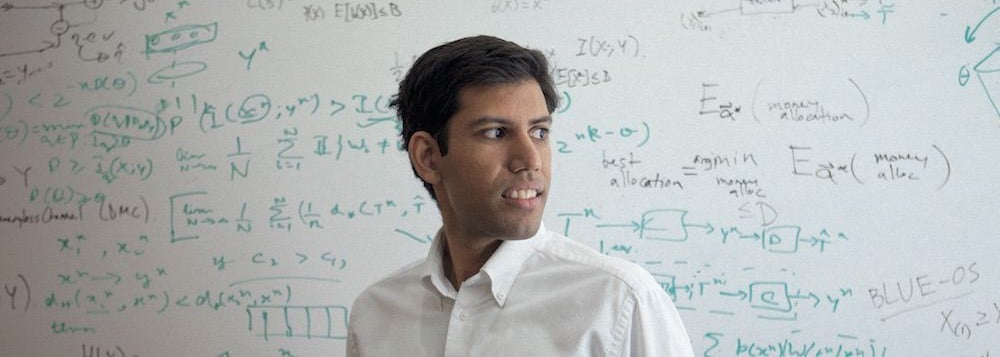Can AI help fix the food system?

Lav Varshney is an Assistant Professor of Electrical & Computer Engineering at the University of Illinois at Urbana-Champaign with a secondary appointment teaching computer science and neuroscience.
He spearheaded IBM’s Chef Watson initiative to create new recipes using artificial intelligence. This project followed IBM’s Deep Blue’s victory over Garry Kasparov, the (human) world chess champion, in 1996 and IBM’s Watson winning Jeopardy! in 2011.
He’ll be discussing how cross-disciplinary R&D is advancing plant-based meat at our Good Food Conference this September. (Have you signed up yet? Now, do it now!) But we got a little preview of his work in culinary computational creativity below. Read on!

Q: You teach electrical and computer engineering, as well as computer science and neuroscience. How did you become interested in food and flavors?
I’ve had a long-standing personal interest in food and food culture, but my foray into research on this topic was a little circuitous. When I worked at IBM, we were all charged with proposing other potential grand challenges after Watson’s success on Jeopardy!
Chess (Deep Blue) involves deductive reasoning regarding where all the pieces are on the board. Jeopardy! (Watson) involves inductive reasoning about the world as it is. So I thought it would be compelling to explore creativity, where the goal is to produce things that have never previously been imagined.
I chose food as the first creative domain for many reasons: food is so central to sustainability and public health; everyone recognizes its cultural importance; and even small changes can have incredible economic impact.
Since my time on the Chef Watson project, I’ve been involved in developing algorithms to identify sources of food contamination. I’ve also become interested in using mathematical models to address problems in food waste and wastewater management by working with a startup called Ensaras, Inc. Further, I’ve had the pleasure of consulting for some large food and beverage companies.
Q: How can data science and artificial intelligence help grow the plant-based market sector?
Flavor is fundamental to changing eating behavior at a population level. The potato is an interesting historical example. It was introduced to Europe during the Columbian Exchange at the beginning of the 15th century and, eventually, led to one-quarter of world population growth and urbanization. But initially, the potato was slow to catch on. (Diderot’s Encyclopedia said, “No matter how you prepare it, the root is tasteless and starchy.” )
The potato only took off when Antoine-Augustin Parmentier—an advocate for the potato—focused his efforts on novelty and when Madame Merigot published flavorful potato recipes in La Cuisiniere Republicaine in 1795.

Now, flavor steganography and artificial intelligence can support the creation of new formulations and recipes that use sustainable, healthy ingredients—such as algae protein—which are traditionally not considered too flavorful.
At a food system level, we can increasingly capture data at the level of individual agricultural fields, individual culinary recipes, and individual food waste digesters. We can use that data to optimize each step along the pipeline: producing, transporting, trading, storing, processing, packaging, wholesaling, retailing, consuming, and disposing of food.
However, to address pressing national and global challenges in food security due to climate change, as well as public health challenges such as obesity and malnutrition, we need to holistically optimize across the entire food pipeline. If we can ensure data flows across the distinct industries—the same way food does—there are exciting possibilities there.
Q: When you were working for IBM, you lead the Chef Watson project, using Artificial Intelligence to create ‘culinary computational creativity.’ What is computational creativity?
Computational creativity involves building artificial intelligence systems that can create novel and high-quality ideas or artifacts automatically. The Chef Watson system that I conceptualized—and whose design and development I led to initial deployment—is a great example in the culinary domain: the system can create unique and flavorful recipes automatically.
The basic idea is to draw on existing recipes and other cultural inputs to generate new ideas and then use models of human perception (built on built on data from the chemoinformatics of food and hedonic psychophysics of flavor) to select the best flavor combinations. After all, a billion ideas are less useful than the three best ideas. There are further algorithms to determine ingredient proportions and recipe steps.
[Are you low-key overwhelmed by “steganography” and “chemoinformatics” ? Me too. Here are some very high-level definitions.]

Q: You’ve spoken about the tension between novelty and quality that’s inherent to creativity. What does that tension look like in the kitchen?
I’ve been working on developing a mathematical theory of creativity (somewhat analogous to Claude Shannon’s information theory), and it does indicate that there is an inherent tension between novelty and quality. It is easy to be high-quality by using your favorite cookbook. It is easy to be high-novelty by putting random ingredients together. The central difficulty is in doing both simultaneously. There are fundamental limits on what can be done.
Q: What was the most surprising but delicious flavor combination that Chef Watson created?
The most intriguing flavor combinations involve not just pairs of ingredients, but higher-order combinations of ingredients that people have trouble reasoning about. The combination of cocoa, saffron, black pepper, and almonds is quite delicious.

